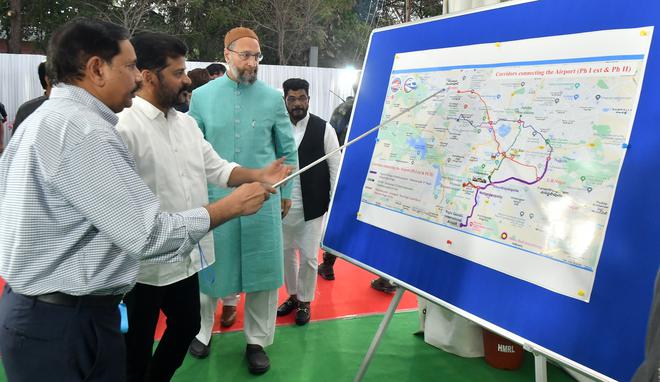The remaining 5.5-km Hyderabad Old City metro route of ₹2,000 crore from MGBS to Falaknuma, for which Chief Minister A. Revanth Reddy had laid the foundation stone a few days ago, is likely to see some forward movement only after the Lok Sabha polls conclude.
It is also because the land acquisition process is yet to be completed as the Hyderabad Metro Rail (HMR) officials are still trying to ascertain the ownership of the 1,100 properties likely to be affected during the proposed road widening to 100 feet or 120 feet where the four overhead stations — Salarjung Museum, Charminar, Shalibanda and Falaknuma, are being planned.

Notices were issued to those utilising the properties on the route and Revenue authorities have been approached for checking the land ownership details. However, with the model code of conduct in force, the process is likely to be completed after the elections.
Metro rail officials have realised about 2.5 km of the 5.5 km does not require much widening because the road is already 80 feet wide from Shahlibanda to Falaknuma. The challenging task will be to widen the road from Darulshifa to Shahalibanda where the road width is about 60 feet and has petty shops functioning from dilapidated buildings on both sides.
“We are trying to ascertain ownership through the Revenue department. In the meantime, we are drawing sketches to firm up engineering solutions with the help of our consultant to circumvent the 103 religious and sensitive structures on the route,” said HMR managing director N.V.S. Reddy.
“We constructed the metro rail viaduct through the Sultan Bazar where the road was just 40 feet wide (for existing Green Line or Corridor two). Yet, it is even more challenging in this part of the city in terms of engineering though we expect cooperation from the public,” he said, in an exclusive interaction.
HMR already has a 500-metre ‘reversal’ viaduct at MGBS built by L&T Metro Rail Hyderabad (L&TMRH) in the first phase for the trains to reverse and move back into the station as the work was halted up to the point. The daunting task will be to match with the existing metro network physically and digitally in the remaining section.
“With another 300 metres of construction, we will cross the Musi River. We are trying to innovate, learning from the experiences of the first phase of the project by going for leaner stations and making a few tweaks to the viaduct,” explained Mr. Reddy, who shepherded the first phase construction built across 69 km across three corridors (Red Line - LB Nagar to Miyapur 29 km; Green Line - JBS to MGBS 11 km & Blue Line - Nagole to Raidurg 29 km).
There will be another reversal viaduct at Falaknuma for about 500 metres. This could be extended up to Chandrayangutta near the flyover by 1.5 km where an interchange station akin to Parade Grounds and JBS stations is to be built later when extension up to the international airport at Shamshabad is taken up in the next phase.
Although HMR is already in possession of 17 acres near Falaknuma for the depot proposed for first phase for the Green Line, no decision has been taken on the usage of this land. Mr. Reddy is also assuring Old City residents of much better footpaths, civic spaces, street furniture and sufficient parking on the route, than the existing first phase. “We should have acquired more land for parking in the first phase; we will correct it in this section,” affirmed Mr. Reddy.







